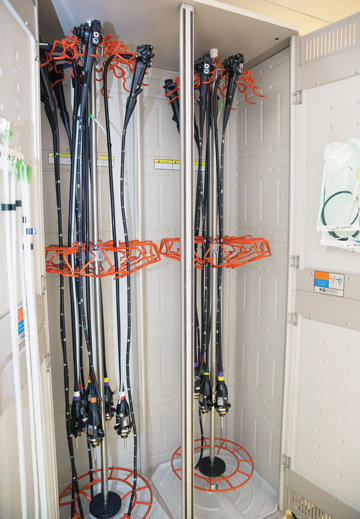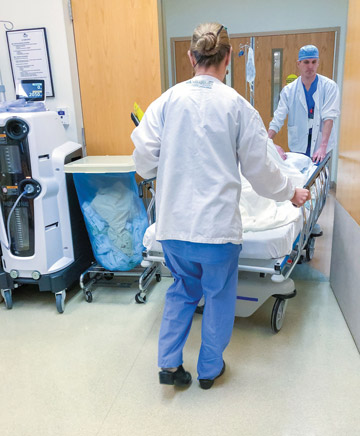We’ve helped plan and build numerous GI centers and know from experience the amount of time and resources top-performing facilities have invested in smart procedure room designs, the latest flexible endoscope technology and reprocessing areas outfitted with patient safety in mind.
- Home
- Article
Gearing Up for GI
By: Keith Mignault
Published: 2/19/2020
Build your program on the essential elements found in leading endoscopy centers.
1. Prioritize reprocessing
Endoscopes are difficult to properly disinfect and preventing infections during endoscopies and colonoscopies is paramount, so the design of the reprocessing department might be the most important place to start when planning a new space. With that in mind, best practice is to frame out 3 different rooms: one for decontamination; one for scope washing and one for drying. At a minimum, there should be 2 rooms with a pass-through automated endoscope reprocessor (AER) between them. A pass-through AER costs about $120,000 — 4 times the price of a traditional unit — but it eliminates the need for a third room. The amount of space you have in the new facility and your budget will guide your choice, but either is preferable to washing and drying instruments in a single open space.
Some AERs include barcode-scanning technology that provides the ability to trace the entire life cycle of the scope. It logs which patient the scope was used on, when it was used, when it enters each phase of the high-level decontamination process, which staff member cleaned and disinfected the scope, when it’s placed into a storage cabinet and when it gets used on the next patient. We suggest investing in one of these reprocessors, at about $60,000 each, for every 2 procedure rooms.
Standard endoscope storage cabinets cost $4,000 or $5,000, but we always advocate that new suites be outfitted with cabinets that have automated air circulating technology, even though they’re twice the cost. When you wash and decontaminate scopes, even though the water is filtered and you’re using a highly disinfecting scope washer, it’s possible to turn the scopes around before they’re dry. When that happens, there’s a risk that chemical and water residue will remain in the internal lumens to increase cross-contamination risks. Storage cabinets with air circulating inside ensures scopes return to the procedure room bone dry.
If the budget permits, more advanced drying cabinets let you attach the lumens of each scope to a drying unit that blows air straight into the scope. They’re as expensive as they are advanced, however, costing $16,000 to $20,000 — 4 to 5 times the cost of a traditional cabinet.
Does air circulating through a storage cabinet keep scopes sufficiently dry? Current evidence suggests it does. But if you’re a very busy, high-volume GI center, the more advanced and most expensive cabinets would let you turn over scopes faster and have them dried in the most effective way for your patients.
A final note about proper endoscope care: These devices are fragile and should be transported back and forth from the procedure room to the reprocessing area in plastic bins. The bins aren’t sealed, but they are closed so there’s no chance of staff or patients being exposed to infectious organisms while the scopes are en route.
Investing in high-end reprocessing technology is certainly more costly, but better overall operations will reduce cross contamination risks for your patients. The success of your entire new venture will in large part be based on the success of your sterile processing department. Don’t make it the least looked-after room in the design phase, or operationally.
2. Efficiency-minded additions

These beyond-the-basics considerations will help your physicians and staff keep pace with a day packed with cases.
- Smart layout. Designing GI suites is pretty straightforward. Procedure rooms should be a little longer than they are wide, with the door in the middle of the wall closest to where the patient’s feet will be. That way, you don’t have to turn the stretcher-bed when pushing it into the room. That makes it easy for one staff member to roll the patient directly into the spot where the procedure will take place.
- Waste management. Consider installing a lavatory within the endoscopy suite. It’s not to be used as a toilet, but as a waste disposal area to dump solid waste. It’s much better than having to walk down a hallway after a procedure to the nearest waste utility room. Having this room directly off the suite limits the area of contamination. You could also consider a fluid waste management system. An in-wall system might be best for a new-construction facility. In that case, you’d put the vacuum system on the back wall that would dump into the house septic system, or you could simply run a portable cart-based suction system and dump the contents into the nearest toilet, utility sink or unit-specific docking port.
- Patient transport. Stretcher beds allow the patient to say in the same bed the entire time. They get on it in the pre-op area, roll into the procedure room, get taken into the recovery area without having to move onto different tables and chairs. These beds reduce the risks of falls during transfers and make for faster case turnover. They cost between $9,000 and $12,000 apiece, depending on how many you buy.
- Equipment organization. Installing a ceiling-mounted boom that houses the imaging equipment, suction equipment, patient monitoring devices and video monitor needed for upper and lower GI procedures adds flexibility to a suite and can improve procedural and room turnover efficiencies. A boom adds about $25,000 to the cost of a room, but it makes things more efficient and eliminates tripping hazards. That said, a lower-volume facility could get away with a cart and working around all the cords. If your center plans on doing bronchoscopies, a C-arm is needed.
3. Buy the right scopes

The cost of an entire fleet of flexible endoscopes will be facility-specific and based on case volume, but in general you’ll need 4 or 5 scopes for each procedure room. A regular flexible endoscope costs about $15,000 to $17,000, while duodenoscopes, EGD scopes and colonoscopes range from $25,000 to $30,000. The size of the center, types of procedures you’ll perform, and the turnaround times of your reprocessing area are all factors in how many scopes you’ll need. You don’t want too many. First, they’re expensive. Second, they have to get re-run through the disinfecting process if they sit for too long.
A 4K imaging chain is ideal if you have the budget for it. Such a system runs from $60,000 to $80,000 for the endoscope, video processor and video monitor.
What matters most
Most GI facilities are designed to move patients through procedure rooms as quickly as possible. The best centers are built with as much of an emphasis placed on where and how endoscopes are reprocessed, because speed should never trump safe patient care. OSM
.svg?sfvrsn=be606e78_3)
.svg?sfvrsn=56b2f850_5)